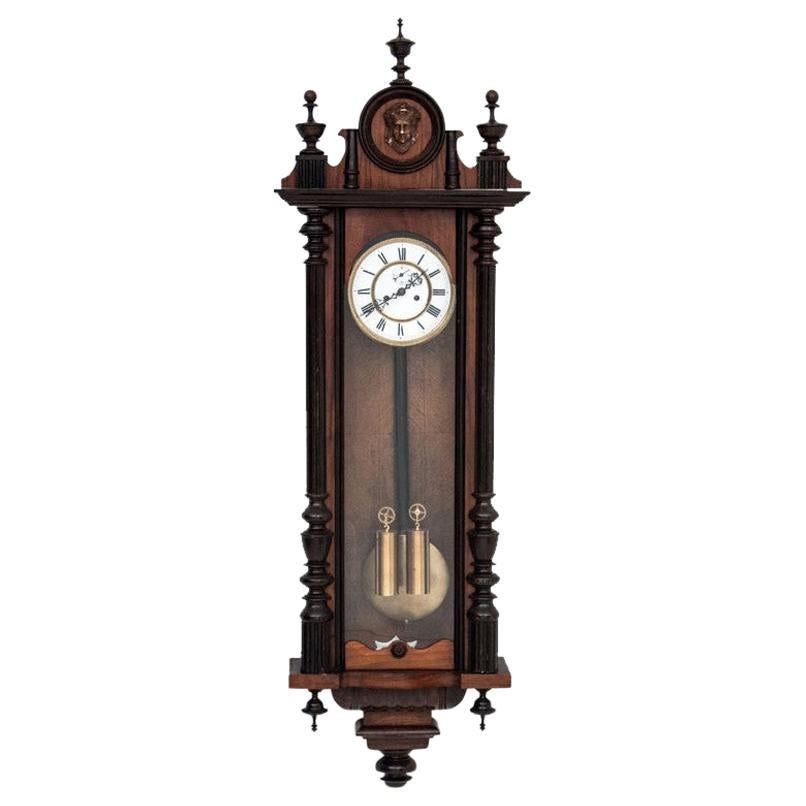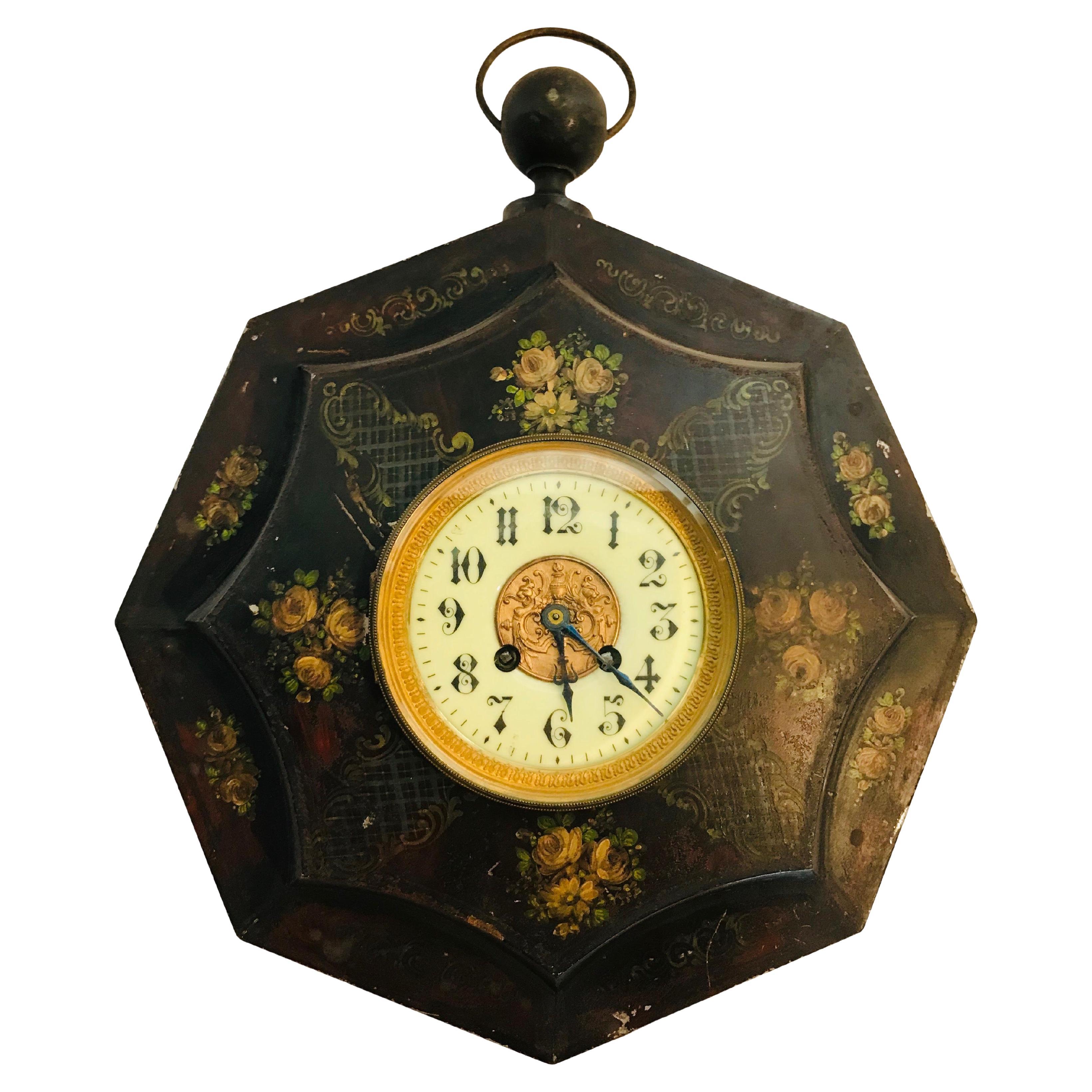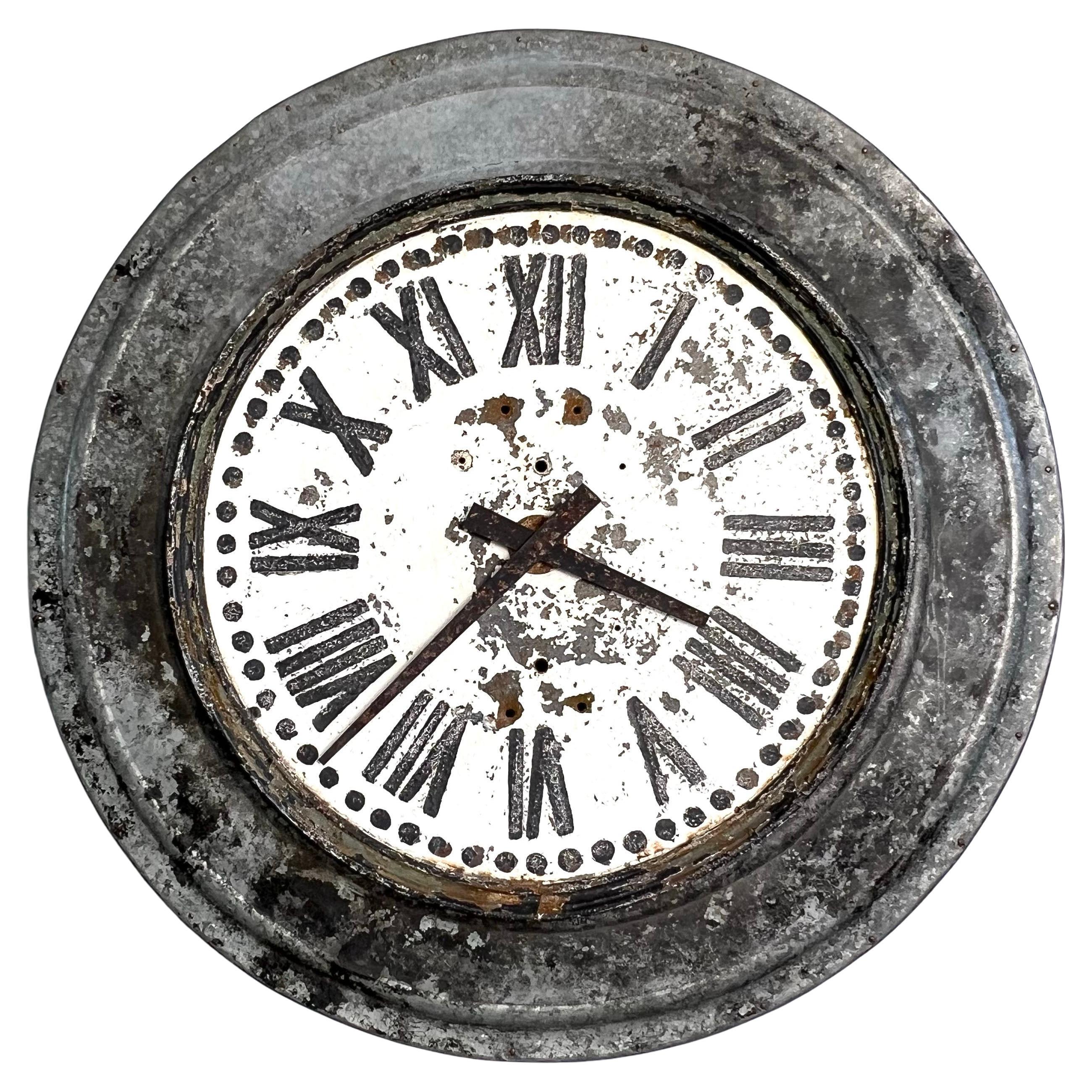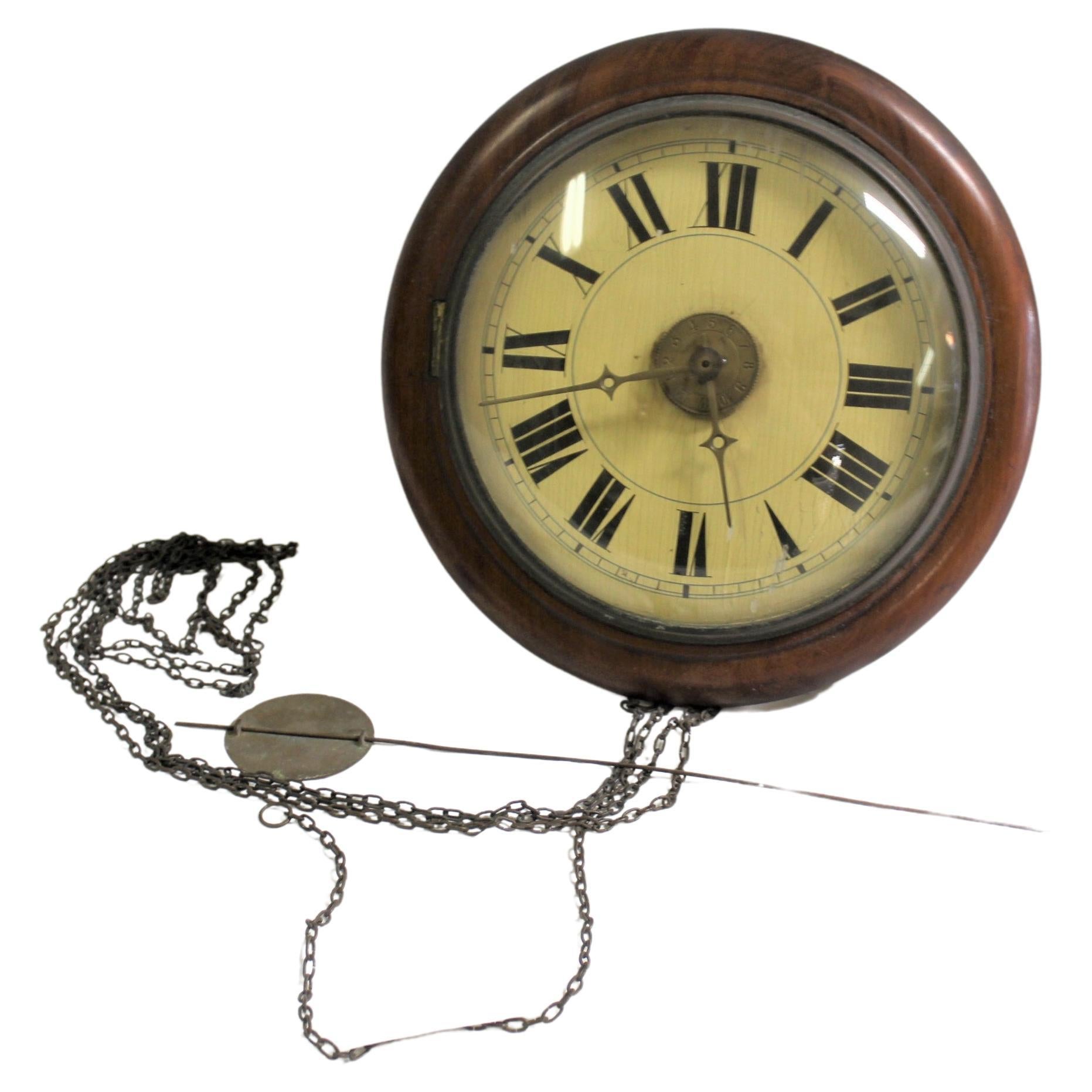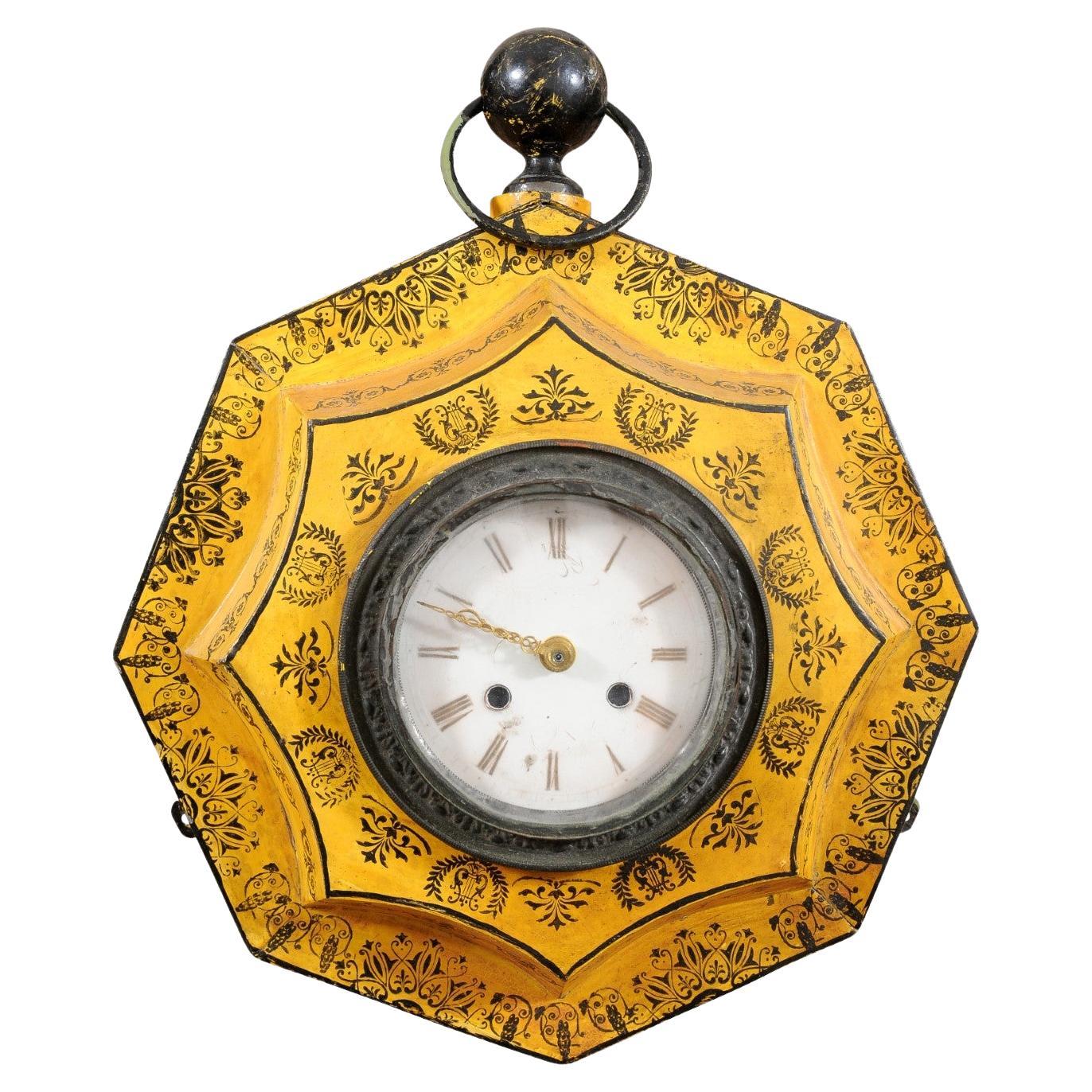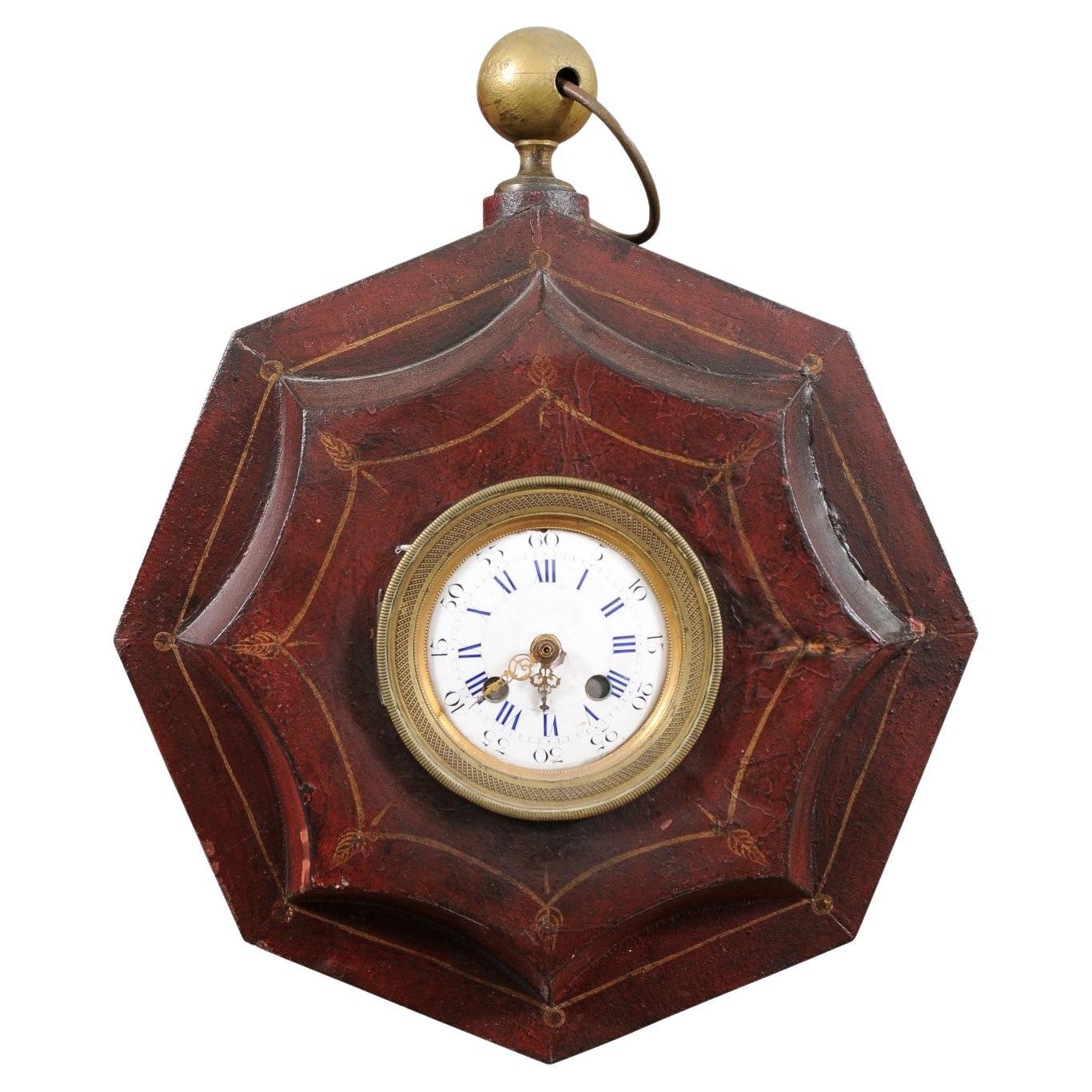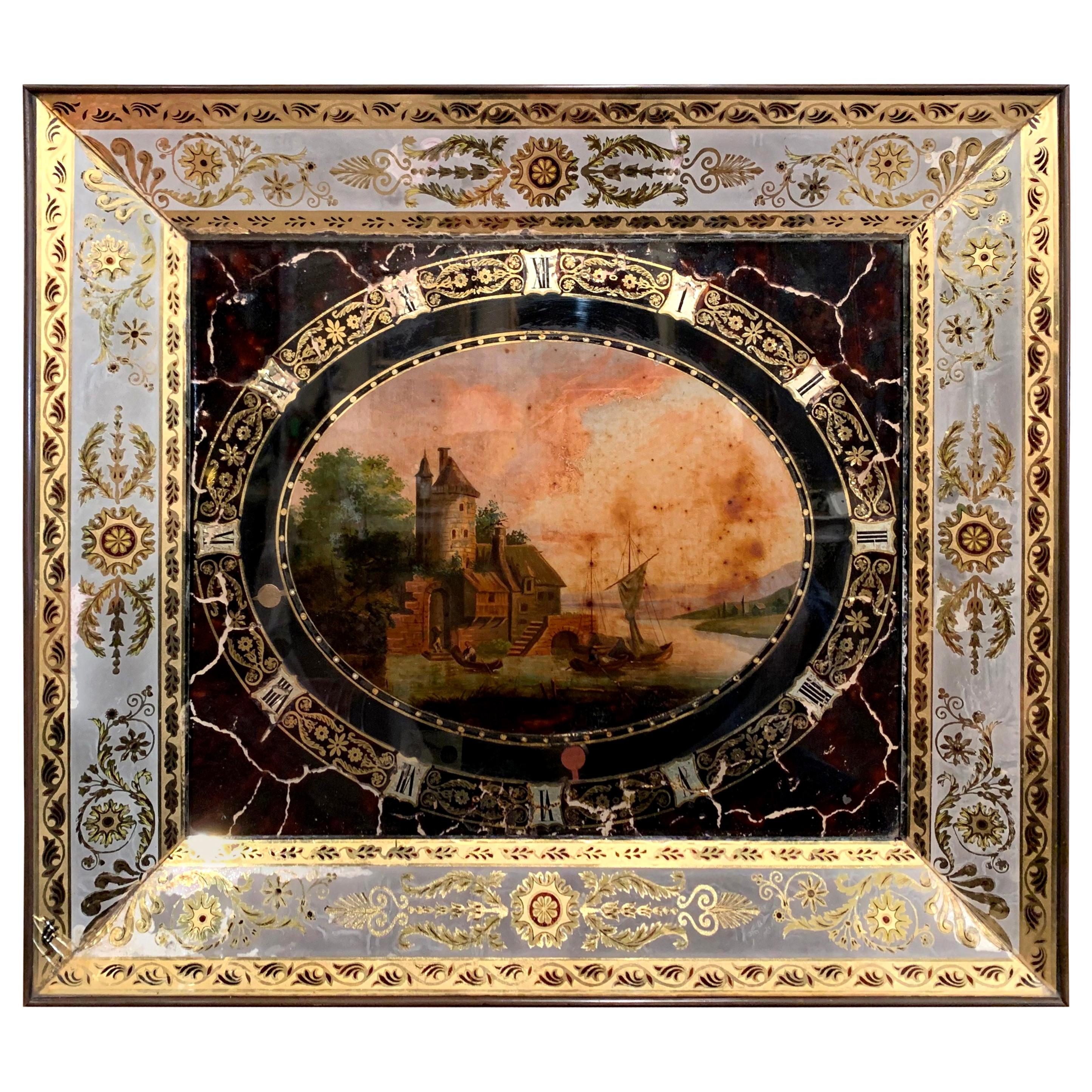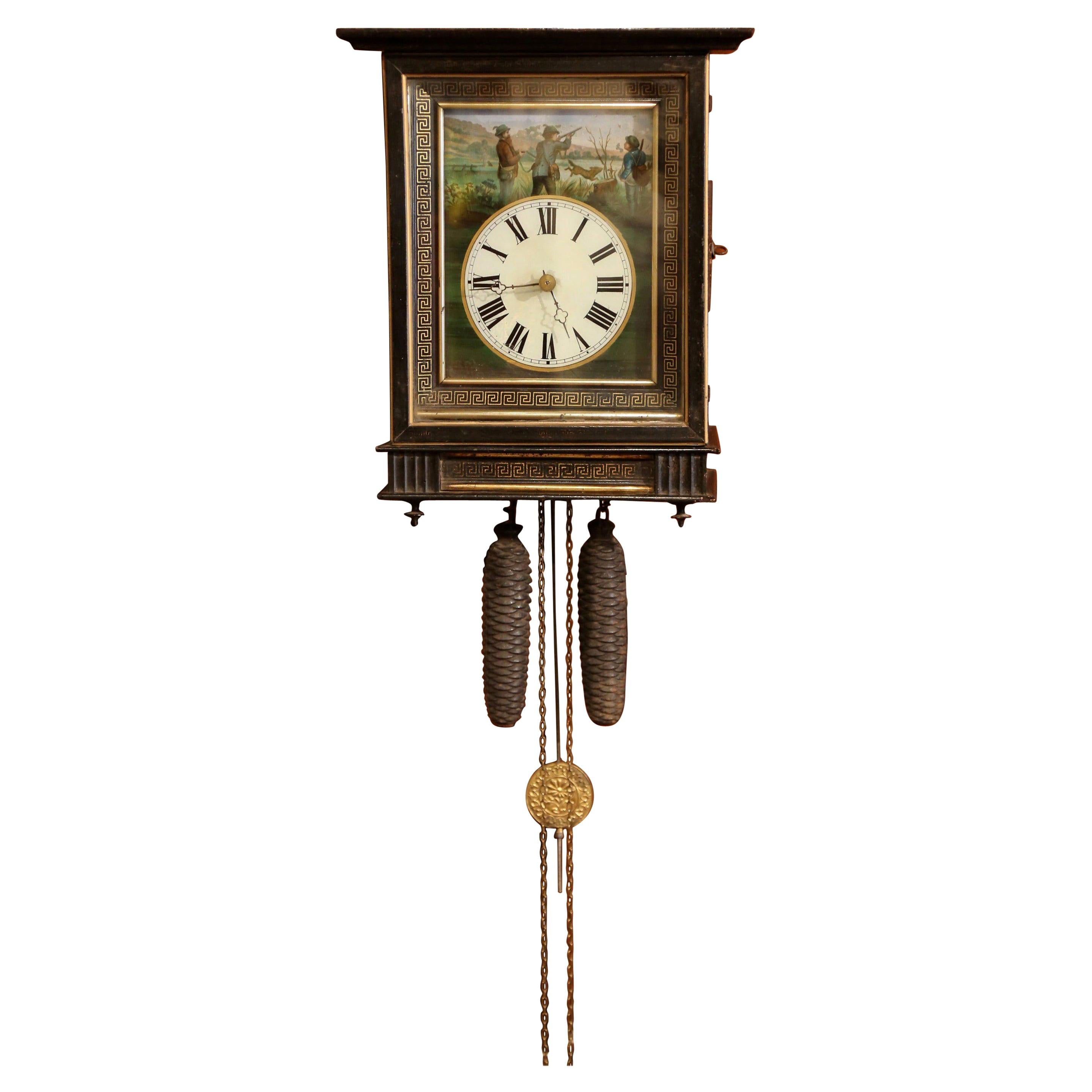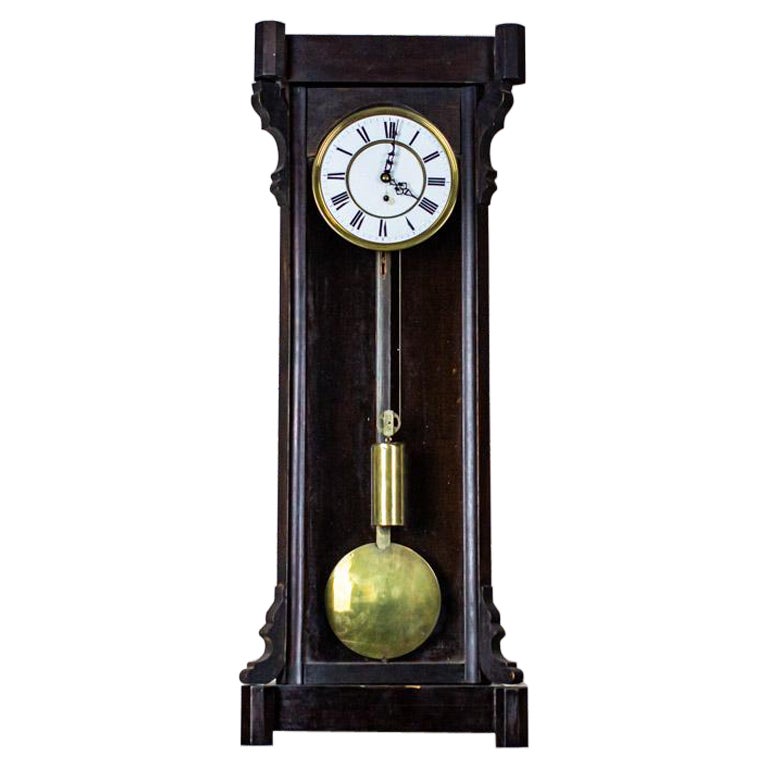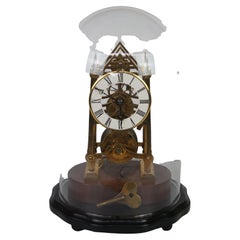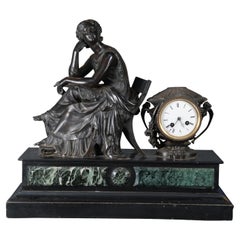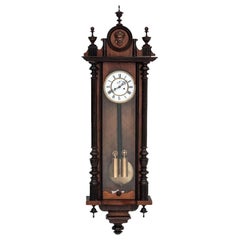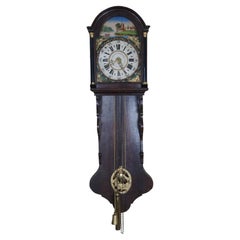
Antique 19th Century Dutch Oak Hand Painted Frisian Tail Staart Wall Clock
View Similar Items
Want more images or videos?
Request additional images or videos from the seller
1 of 13
Antique 19th Century Dutch Oak Hand Painted Frisian Tail Staart Wall Clock
About the Item
- Dimensions:Height: 49 in (124.46 cm)Width: 15.5 in (39.37 cm)Depth: 9 in (22.86 cm)
- Style:Dutch Colonial (In the Style Of)
- Materials and Techniques:
- Period:
- Date of Manufacture:Circa 1850s
- Condition:Additions or alterations made to the original: Clock is currently keeping time & chiming at the half & full hour. Missing pulley that would have held central weight in place. Without it you have to move and re-hang the weight more frequently. Wear consistent with age and use. Good Overall - Age/use related wear. Splits in case along right edge of tail, bronze mount along tail near bottom right, & door. Lower left capital on face missing. Some paint wear to the face. Missing one of the pin mounts for the face.
- Seller Location:Dayton, OH
- Reference Number:Seller: 378921stDibs: LU5343234102132
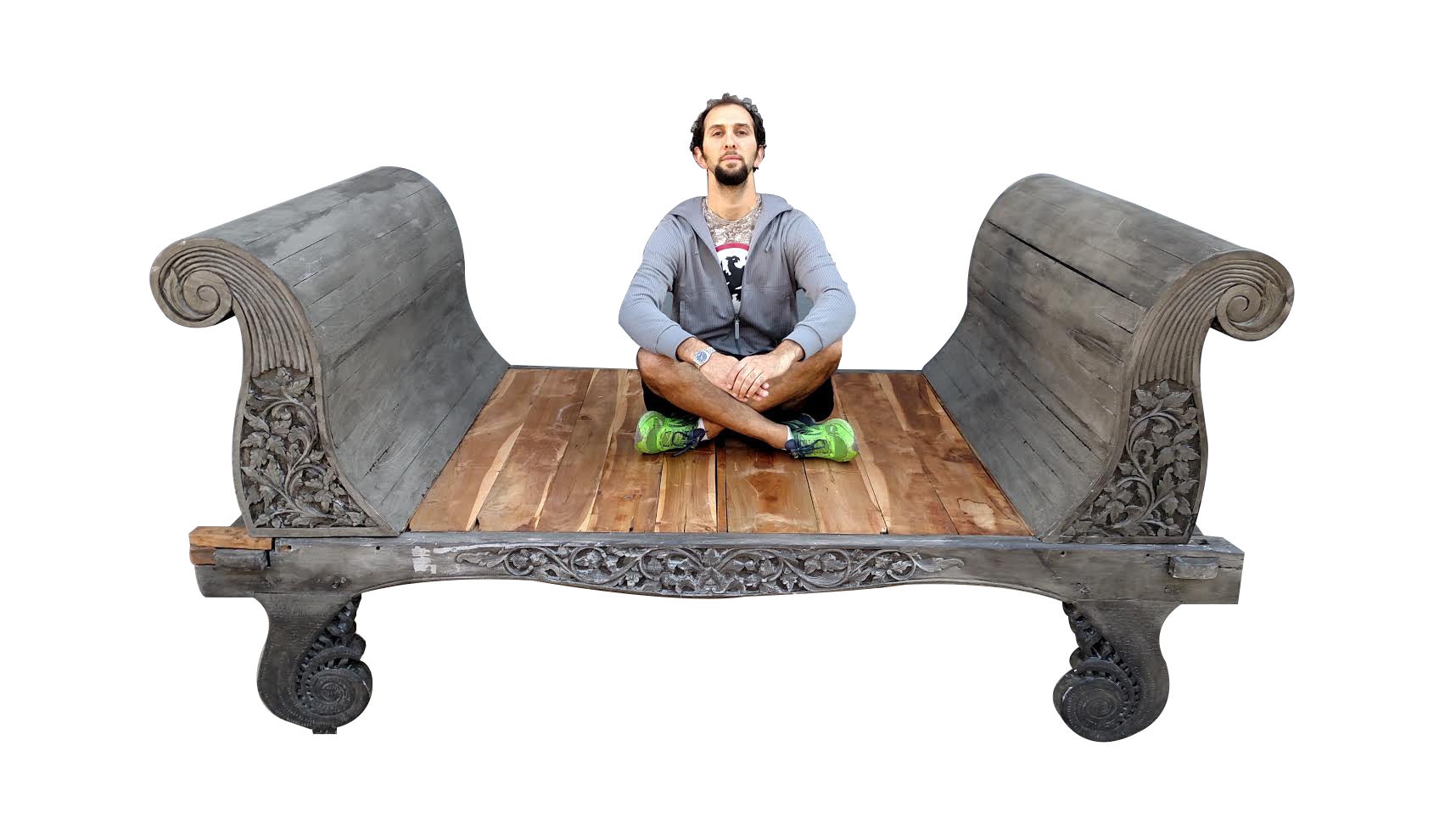
About the Seller
4.9
Platinum Seller
These expertly vetted sellers are 1stDibs' most experienced sellers and are rated highest by our customers.
Established in 2010
1stDibs seller since 2020
1,121 sales on 1stDibs
More From This SellerView All
- Antique English 19th Century 8 Day Fusee Skeleton Cathedral Glass Dome ClockLocated in Dayton, OHAntique mid 19th century 8 day skeleton clock. Centrally mounted on wood base featuring exposed Fusee movement and protected from dust by a glass dome.Category
Antique Mid-19th Century Victorian Table Clocks and Desk Clocks
MaterialsGlass, Hardwood
$1,725 Sale Price25% Off - Antique 19th Century French AD Mougin Gilt Bronze Mantel Garniture Clock & UrnsBy A.D. MouginLocated in Dayton, OH"Antique AD Mougin French figural garniture clock and mantel urns. Made of marble and bronze with gilt accents and neoclassical styling featuring a figural b...Category
Antique Late 19th Century French Provincial Garniture
MaterialsMarble, Bronze
- Antique French 19th C Japy Fil Classical Figure Bronze Slate Marble Mantel ClockBy Japy FrèresLocated in Dayton, OHA beautiful 19th Century French Mantel Clock. Features a seated woman in the thinker position. She is wearing a large flowing dress, sitting on a Klismos chair with footed raised ove...Category
Antique Late 19th Century French Provincial Mantel Clocks
MaterialsSlate, Bronze
- Antique German Walnut Inlaid Mother of Pearl Short Drop Peekaboo Wall Clock 23"Located in Dayton, OHAntique short drop wall clock featuring a round beveled frame accented with inlaid mother of pearl cut-out leaf designs. The drop features an oval peekaboo window framed in black met...Category
Early 20th Century Wall Clocks
MaterialsMother-of-Pearl, Glass, Walnut
- Rare Self Winding Clock Co Naval Observatory Time Western Union Wall Clock 26"By Self Winding Clock Co.Located in Dayton, OHAntique Western Union, Naval Observatory Time, self winding clock. Features a tall wooden case with carved corners and pediment mounted with tin sign reading "Naval Observatory Time Hourly By Western Union. White metal face with black Roman numerals and hands. Interior of case labeled "Property of Self-Winging Clock Co New York" and serial number on metal tag as well as on works. F Style / Vibrator movement, Serial Number 92630 (likely manufactured before 1917). Patented Oct. 4, 1898 by the Self Winding Clock Company. Fitted with Archer AC Adapter. "The Self Winding Clock Company (SWCC) of New York began business in 1886 marketing their own electro-mechanical clocks based on the 1884 electro-mechanical clock patent of one of the company founders, Chester Pond (1844-1912). The innovative principle of this clock mechanism was the incorporation of a small electric winding motor that automatically rewound the mainspring after the clock ran for one hour. The clocks were powered by batteries. The batteries would last at least one year. By being automatically rewound each hour, the strain on the mechanism was kept to a minimum, resulting in a very accurate timepiece. At about the same time SWCC began selling clocks, Pond was developing an electro-mechanical synchronizer attached to the clock movement that could synchronize the clock hands to an accurate time source. The synchronization occurs when a remote, precisely timed, electrical impulse is sent via wires connected to the individual clocks. By 1887 the synchronizers had been so improved that the Self Winding Clock Company could not only market individual clocks but also sell entire synchronized clock systems. By the 1960’s the days of individual elegant mechanical timepieces and synchronized time systems were over. SWCC ceased operations in the late 1960’s. All company records and inventories were relegated to the trash pile. The STYLE “F”, or as commonly referred to, the VIBRATOR movement was developed by Frederick M. Schmidt in the late 1890’s. By 1898 the “F” movement was being installed in almost all SWCC clocks. The movement has a Graham dead beat escapement. The “F” movement incorporates both the time train and winding motor in one set of plates. The motor used a single pair of coils. It was more reliable and easier to service than the rotary movement. The mainspring is re-wound after running for one hour. The vibrating armature oscillates up and down carrying a winding lever with a pawl that turns the winding wheel. The “F” movement was used in individual clocks and in clocks that were part of synchronized systems. It was made in 60, 80,120 and 140 beat versions. There were virtually no changes to the movement in 60 plus years the movement was in production. Almost all Style “F” movements wound on 3 volts DC. Style “F” movement serial numbers started in the 33,000’s and the first movements were probably made in 1898. The earliest plates had patent dates of 1891, 1892 & 1898. Serial numbers with these patent dates go up to the 63,000’s and were made before 1908. By 1908 the plates only had the 1898 patent date. By using catalog images of movement serial numbers it can be concluded that movements with serial numbers up to 112,000 were made in or before 1917. Movements with serial numbers up to 196,000’s were made in or before 1929. The single patent date serial numbers go as high as 220,000’s. Then there appears to be a large numbering gap. Finally, movements appear with no patent dates and serial numbers with the prefix FR. These numbers start at 300,000 but only continue to about 302,000. Start again at 400,000 and continue to about 402,000. Based on the large serial number gaps, the total number of “F” movements manufactured is probably around 200,000. They were manufactured between 1898 and possibly as late as the 1950’s. SWCC both sold clocks to and partnered with their biggest customer, Western Union in a nationwide distribution of precisely accurate “Naval Observatory Time” clocks. These either 120 or 140 beat Naval Observatory clocks...Category
Early 20th Century Late Victorian Wall Clocks
MaterialsMetal
- Antique 19th Century Dutch 800 Silver Baroque Figural Tankard Stein 835gLocated in Dayton, OHRare antique 19th century Dutch lidded and footed 800 silver tankard/stein / pitcher, with ornate designs, faces and finial; gilded interior. Marked on base “JW 800M.” Provenance: Jerome Schottenstein Estate, Columbus Ohio. Jerome was was an American entrepreneur and philanthropist, co-founder of Schottenstein Stores Corp. The Schottenstein family were Lithuanian immigrants who began an extensive business empire in the late 19th Century. Schottenstein Stores owns stakes in DSW and American Signature Furniture...Category
Antique 19th Century Dutch Colonial Barware
MaterialsSilver
You May Also Like
- Antique Wall Clock, Late 19th CenturyLocated in Chorzów, PLThe clock is functional, after the clockmaster review Year: The end of the 19th century Origin: Western Europe Dimensions: Height 133 cm / width 42 cm / depth 17 cm.Category
Antique Late 19th Century Belgian Other Wall Clocks
MaterialsOak
$835 Sale Price20% Off - 19th Century Tole Painted Decorative Wall ClockLocated in Charlottesville, VAFrench Tole Wall Clock, non working. For decorative use only. It adds charm to any room.Category
Antique 19th Century French Wall Clocks
MaterialsMetal
- 19th Century Zinc 'Clock Tower' Antique Wall ClockLocated in Cirencester, GBSourced in the South of France we love the patina to this large zinc clock. We have replaced the clock mechanism with a new battery high torque system.Category
Antique 1890s French French Provincial Wall Clocks
MaterialsZinc
- 19th Century Antique Wall Clock, Wood GermanLocated in Los Angeles, CAA rare find Antique French or maybe German wall clock. All wood frame with hand made brass gears. The dial is painted and shows the old paint cracks. I beli...Category
Early 20th Century French French Provincial Wall Clocks
MaterialsWood
- 19th Century French Yellow Painted Tole Wall ClockLocated in Atlanta, GA19th Century French Yellow Painted Tole Wall ClockCategory
Antique 19th Century French Wall Clocks
MaterialsMetal
- 19th Century French Red Painted Tole Wall ClockLocated in Atlanta, GA19th Century French Red Painted Tole Wall ClockCategory
Antique 19th Century French Wall Clocks
MaterialsMetal
Recently Viewed
View AllMore Ways To Browse
Dutch Long Case Clock
Antique Oak Pendulum Wall Clock
Dutch Antique Wall Clocks
Antique Dutch Wall Clocks
Antique Dutch Wall Clock Wall Clocks
Antique Dutch Wall Clock
Gustav Becker Antique Wall Clocks
Gustav Becker Wall Clock
Ac Gmt Co
Ac Gmt
Seiko Gmt Vintage
Seiko Vintage Gmt
P Caffieri
Vienna Regulator Wall Clock
Vintage Maritime Clocks
Wall Clocks Vienna Regulator
Antique Black Forest Clock Cuckoo Black Forest
Antique Black Forest Cuckoo Clock Antique Clocks
